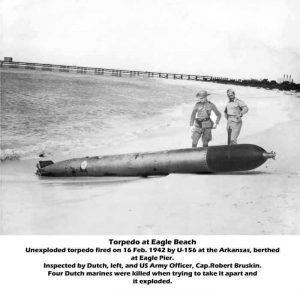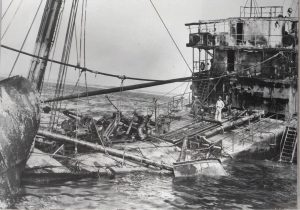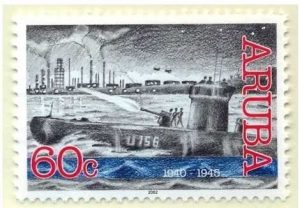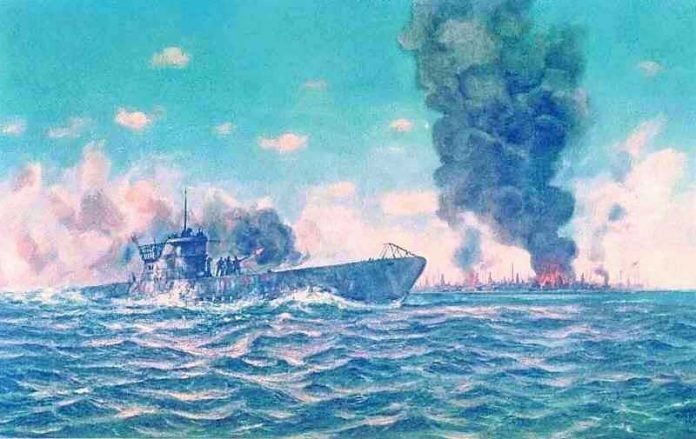The small island of Aruba played a very important role in the Second World War. At that time, the Lago was one of the largest refineries in the world in terms of production. The gasoline refined at Lago was used for the Allied planes and so the island became a vital point in the Western Hemisphere: for the Americans to defend and for the Germans to attack. Torpedoes were fired on ships and on the Aruban coast.


Already in 1939, when the threat of war was in the air, the first measures were taken for the defense of the island and the refinery. At Juana Morto, the highest point on the eastern part of the island, a coastal battery was built with views over the refinery and the North and West coasts.
Aruba was regularly visited by German ships in those years, but when the Germans invaded the Netherlands and war broke out between the two countries, only the German ship Antilla was anchored at Malmok. Since it was now a ship belonging to a nation with which the Netherlands was at war, the ship was surrounded by soldiers and the crew was ordered to surrender. When threatened with violence, the crew boarded lifeboats and the captain set the ship on fire. It broke in half and sank just offshore. The crew was detained and later transferred to the internment camp on Bonaire, as well as other Germans living or staying on the island. On the evening of May 10, 180 French marines landed in Aruba to assist in the defense of the island. The Lago was reinforced with anti-aircraft guns and Oranjestad and San Nicolas were darkened at night, as were the two refineries, the Lago and the Arend.
In July 1940, the French troops were relieved by English and Scottish troops. Aruba itself only had a small regiment of soldiers, the Volunteer Korps Aruba (V.K.A.). That is why conscription was introduced and in December 1940 the first batch appeared. To meet the need for shelter for the military, construction was done in Oranjestad and in Savaneta. In Oranjestad, a shelter for officers was built, which after the war served as a so-called pasanggrahan and then continued to serve as a government office for decades. Behind it, the NCO’s quarters was built, which later became the Recipient’s Office. The buildings along the harbor of Oranjestad, which after the war were converted into a cinema, restaurant and department stores by businessman De Veer, were converted during the war as canteens and dormitories. In Savaneta a camp was built for Scottish troops (The Cameron Highlanders) and after the war for the Dutch Marine Corps.
In late 1941, America became involved in the war and the entire Caribbean came under American surveillance. In January 1942 the first American soldiers arrived in Aruba, after which the Scots left again. Heavy American bombers visited Aruba and the Dakota airport was actually too small for that. The runway was extended and had to be re-paved. Large camouflaged parking spaces for the American planes were built around the airport. The area was cordoned off with barbed wire and guarded by American soldiers.
The Attack
On the night of February 16, a large-scale attack by the German submarine U-156 took place. Several torpedoes hit ships lying off the coast or in port. The Pedernales was the first, the Oranjestad the next to be hit. Both ships caught fire and sank. More followed that night. The number of victims was large. Some Arubans, still unaware of the importance of being darkened during a bombardment in the dark, turned on their lights in the house and drove the car, headlights on, to the coast, hoping to spot the submarine.
The main target for the submarine, however, was Lago. In those days there was no eclipse, the target was there in full light. After firing the torpedoes, U-156 surfaced and they hurried to prepare the heavy guns on deck of the submarine to bombard the refinery. In the excitement of the moment, however, the gunner on duty forgot to release the shut-off valve at the bottom of the cannon: when firing the first projectile, the heavy cannon exploded killing the gunner.
This fatal mistake escaped the Lago from virtually total destruction, because after the loss of this cannon the submarine only had much lighter guns on board. The refinery and the buildings around it were still fired with this, but the damage was very limited. For example, Aruba crawled through the eye of the needle that night, but not only because of the failure of the bombardment of the Lago: there was another ship, loaded with 3000 tons of TNT (dynamite), in the harbor. The Henry Gibbons had not yet set sail when the torpedo attack began. The crew first wanted to drink coffee before choosing the sea. With a direct hit, the destruction on Aruba would have been unimaginably great.
A day later, a torpedo was found on the beach near the Arend refinery. In an unsuccessful attempt to dismantle it, some soldiers were killed.
After the attack on San Nicolas and Lago, the inhabitants of San Nicolas began to move away. Many Arubans went to Santa Cruz, families of Americans traveled back to the US via Maracaibo. Immediately after the attack, artillery positions began: tent camps were erected at the Seroe Colorado lighthouse and at Seagrape Cove. The tankers that had to bring oil from Lake Maracaibo to Aruba had to proceed very carefully from now on: they only sailed in convoys accompanied by naval vessels and patrolling aircraft. Also in 1944 a few ships were torpedoed off the coast of Aruba.
From 1942, the water and food supply was precarious in Aruba. This was due to the large number of people, mainly soldiers, that had been added and, moreover, a lot was built. As always they were completely dependent on supplies from outside, but the Battle of the Atlantic raged in all its fierce and many boats with food and material did not make the crossing.
The legend of U-156
The story of U-156 also mentions that, in addition to a fatality, there was also a seriously injured crew member who lost his leg in the explosion. This seriously injured person was brought to Martinique after U-156 had withdrawn from Aruban waters. This was French territory, but took a neutral position. There was a military hospital and the wounded was left there for treatment. By the way, things didn’t end well with U-156: a year later, when the U-boat (with and other crew) surfaced elsewhere in the Caribbean during a patrol mission at one point and was not on his guard, an American bomber suddenly appeared and seized the submarine. U-156 was wrecked with man and mouse. How the story of the exploded guns came to be found is a chapter of its own: in the years after the war, an American staff member of the Lago decided to spend his several months leave in Europe. As was customary at the time, he took his car on vacation. And so an American car with Aruban license plates drove through Europe. When he was in Germany at one point and drove into a gas station to refuel, he was helped by a somewhat infirm man; at the sight of the Aruban license plate, the German exclaimed: “Ah, that’s where I lost my leg!” And that’s how this story came about.
The history of U-boat expeditions has been exhaustively researched by various historians and so is this story. After the war, the logs of the U-boats and also of the U-156 were captured by the Allies from the Germans. The story of the exploded guns could thus be confirmed.
For more about the attack on Aruba in World War II see: www.lago-colony.com, under World War II.
Source: http://www.historiadiaruba.aw/.




















